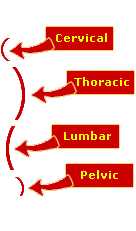|
Anatomy
  The
structure of the back allows it to support our head, to provide anchor points for the rest of our skeleton, and provide flexibility when we move. The
structure of the back allows it to support our head, to provide anchor points for the rest of our skeleton, and provide flexibility when we move.
The vertebral column is formed of 33
bones, called vertebrae. It has four curves, two of which,
thoracic and pelvic, are concave and are formed before we are born. The
other two, cervical and lumbar, are convex and are formed when we begin
to sit up and walk.
The vertebrae are bound together by powerful ligaments, and stabilised by small muscles along the entire length of each side of the
vertebral column. The joints between the bones of the lumbar, thoracic and cervical regions are slightly moveable and contain fibro-cartilaginous structures called discs. The discs act as buffers (shock absorbers) between the vertebrae to withstand forces of compression.
Although the amount of movement between
any two vertebrae is limited, the sum of the movements which take place at
all the joints make the spine, as a whole, a very mobile structure. The
spine can bend forwards (flexion), backwards (extension) and sideways
(lateral flexion), and can twist (rotation).
Good
posture
The posture that you adopt when performing a
manual handling activity is determined mostly by what you need to see to do the task, and how
you handle the load. For example, if you are pushing a tall load then you
might bend sideways to see around the side. A good posture is efficient
in terms of the amount of muscular effort required, and does not result in
discomfort or injury. Certain sorts of handling place your back at
risk of injury because the combination of poor posture and heavy load
place too much strain on it.
The muscles and joints in your back
receive least strain when you are upright and are maintaining your natural
curves in your spine. Therefore, you will be putting least strain on your
back if you do manual handing activities with your back in this
position. Remember too, that
generally your muscles are strongest in their middle third range of
movement. This means that your arms muscles, for example, will be better
able to cope with a lift when your elbows are bent.
|